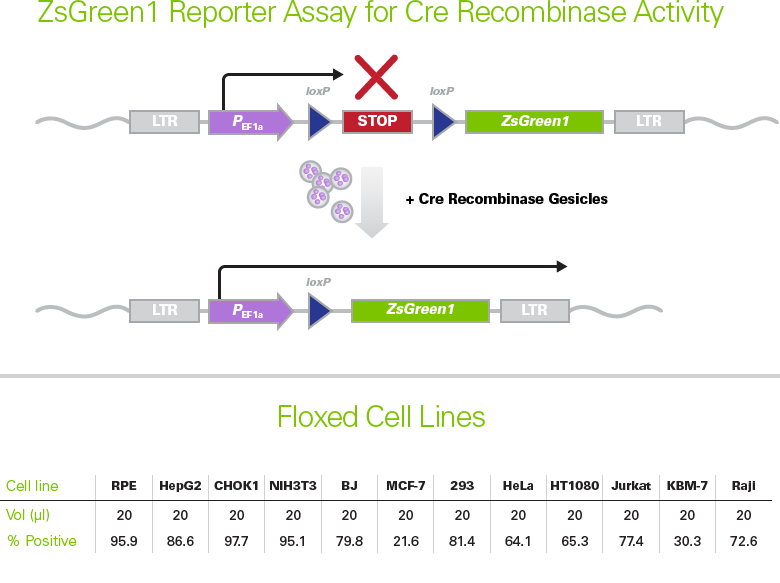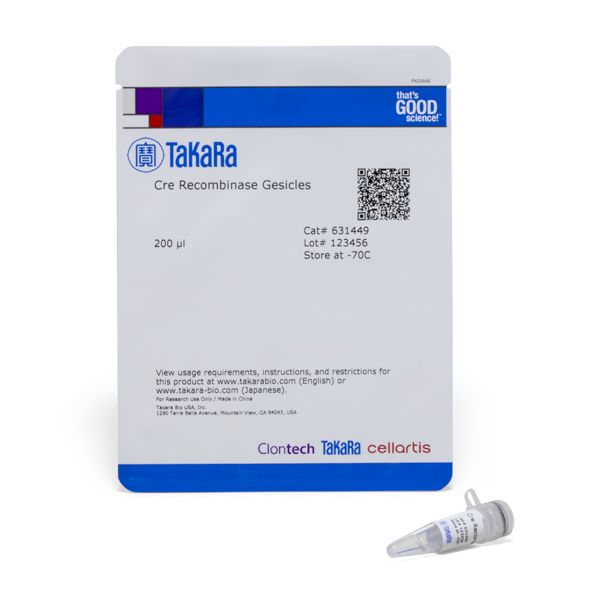Cre Recombinase Gesicles
Cre Recombinase Gesicles
Tools for delivering Cre recombinase
Cre Recombinase Gesicles are cell-derived nanovesicles used to deliver active Cre recombinase protein directly into target cells. When they are applied to your target cells, the gesicles fuse with the plasma membrane and deliver a temporary dose of Cre recombinase, which facilitates recombination at loxP sites contained within the cell. As an added benefit, Cre Recombinase Gesicles contain CherryPicker protein, a membrane-targeted version of the mCherry fluorescent protein that helps to confirm the delivery of the Cre recombinase to your target cells.
Applications
- For knockout and knockin studies
- Limit and control site-specific recombination events including deletions, insertions, translocations, and inversions
What is Cre recombinase?
Cre recombinase is a site-specific recombinase isolated from P1 bacteriophage that catalyzes the recombination between two 34-bp loxP sites. The enzyme is widely used for knock-out and knock-in studies: any DNA sequence located between two tandem repeats of loxP can be excised to create a deletion mutant, or a plasmid containing a single loxP site can undergo site-specific integration into a genome containing loxP to create an insertion mutant.
What are the benefits of gesicle technology?
- Far simpler to use than either plasmid or viral gene delivery. Simply apply 10–20 µl of the gesicles to your target cells; no preparation or pre-treatment is required.
- Flox your cells on demand: Cre recombinase is present when you need it and gone when you don’t.
- Can be used with many cell types, including dividing and non-dividing cells, primary cells, and cell lines.
- Ensure efficient delivery and high activity of Cre recombinase (expand the Details tab in the product table to see data images). When using gesicle delivery, there is no delay for transcription/translation: the protein is present and active as soon as you apply the gesicles to your cells.
- Since there is no coding gene present, there is no risk of sustained Cre recombinase expression in your target cells. It is present when you need it and gone when you don’t, so you avoid unwanted recombination events.
293T cells are used to produce Cre Recombinase Gesicles, which allow rapid and efficient genome modification in the target cells of your choice

293T cells are used to produce Cre Recombinase Gesicles, which allow rapid and efficient genome modification in the target cells of your choice. Nanovesicle-inducing glycoproteins stimulate gesicle formation from the 293T cell line. iDimerize technology incorporates Cre recombinase into the gesicles and associates it with CherryPicker red fluorescent protein. After the gesicles pinch off from the producer cells, they fuse with the plasma membrane of the target cells and release Cre recombinase into the cell. The CherryPicker protein provides convenient visualization of delivery to your cells.
ZsGreen1 reporter assay for efficiency of Cre Recombinase Gesicles with various cell lines

ZsGreen1 reporter assay for efficiency of Cre Recombinase Gesicles with various cell lines. pLVX-LoxP-ZsGreen1 contains ZsGreen1 cDNA separated from the EF1a promoter by a floxed stop cassette. In the presence of Cre recombinase, the stop cassette is removed, permitting high-level expression of ZsGreen1. All cell lines were transduced with this vector, followed by selection in puromycin to create stable lines. These lines were then exposed to a dilution series of recombinase-containing gesicles, centrifuged at 1,000 x g for 30 min at 32°C, and incubated for an additional 3 hr at 37°C. After 3 hr, media was exchanged and cells were permitted to grow for an additional 48 hr, at which time they were analyzed by FACS for ZsGreen1 expression.
LacZ Reporter Assay for Cre Recombinase Gesicles

LacZ Reporter Assay for Cre Recombinase Gesicles. Panel A. Gesicle effectiveness was tested using a reporter cell line in which the lacZ gene is only expressed following removal of a stop codon by Cre recombinase activity. Cells were either transfected for 6 hr with a plasmid expressing Cre recombinase, or treated with 20 µl Cre Recombinase Gesicles for 3 hr. 24 hr after treatment, cells were stained for lacZ expression using the Beta Galactosidase Staining Kit (Cat. No. 31780). Panel B. The high concentration of blue cells in the center image indicate high recombinase activity. Red fluorescence in the right-hand image provides easy visualization of gesicle delivery to target cells.
Visualization of ZsGreen1 reporter assay for Cre Recombinase Gesicles in various cell lines

Visualization of ZsGreen1 reporter assay for Cre Recombinase Gesicles in various cell lines. pLVX-LoxP-ZsGreen1 contains ZsGreen1 cDNA separated from the EF1a promoter by a floxed stop cassette. In the presence of Cre recombinase, the stop cassette is removed, permitting high-level expression of ZsGreen1. All cell lines were transduced with this vector, followed by selection in puromycin to create stable lines. These lines were then exposed to a dilution series of recombinase-containing gesicles, centrifuged at 1,000 x g for 30 min at 32°C, and incubated for an additional 3 hr at 37°C. After 3 hr, media was exchanged and cells were permitted to grow for an additional 48 hr, at which time they were imaged by fluorescence microscopy for ZsGreen1 expression.


